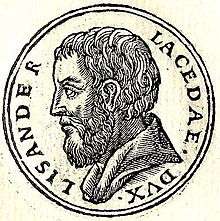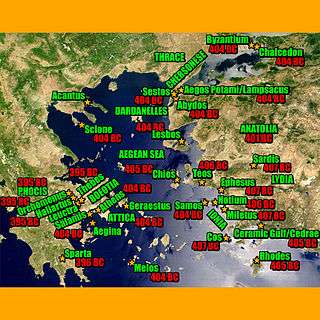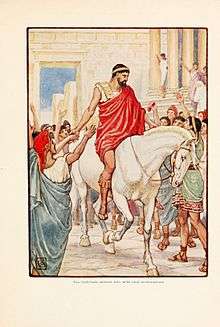Lysander

Lysander (/laɪˈsændər/ or /ˈlaɪˌsændər/; died 395 BC, Greek: Λύσανδρος, Lýsandros) was a Spartan admiral who commanded the Spartan fleet in the Hellespont which defeated the Athenians at Aegospotami in 405 BC. The following year, he was able to force the Athenians to capitulate, bringing the Peloponnesian War to an end; he organized the dominion of Sparta over Greece in the last decade of his life.
Early life
Little is known of Lysander's early life. Lysander's father was Aristocleitus, who was a member of the Spartan Heracleidae; that is, like most Dorian men of good family, he claimed descent from Heracles. Nevertheless, Lysander was a mothax: his family was poor and he showed himself obedient and conformable. He had a manly spirit and showed himself superior to pleasure. When he was young he needed sponsorship to be able to participate in the Spartan training to be a soldier.
The Battle of Notium

Lysander was appointed Spartan navarch (admiral) for the Aegean Sea in 407 BC. It was during this period that he gained the friendship and support of Cyrus the Younger, a son of Darius II of Persia and Parysatis.
Lysander then undertook the major project of creating a strong Spartan fleet based at Ephesus which could take on the Athenians and their allies.[1][2]
Alcibiades was appointed commander-in-chief with autocratic powers of the Athenian forces and left for Samos to rejoin his fleet and try and engage Lysander in battle. The Spartan navarch Lysander refused to be lured out of Ephesus to do battle with Alcibiades. However, while Alcibiades was away seeking supplies, the Athenian squadron was placed under the command of Antiochus, his helmsman. During this time Lysander managed to engage the Athenian fleet and they were routed by the Spartan fleet (with the help of the Persians under Cyrus) at the Battle of Notium in 406 BC. This defeat by Lysander gave the enemies of Alcibiades the excuse they needed to strip him of his command. He never returned again to Athens. He sailed north to the land he owned in the Thracian Chersonese.
Lysander out of office
However, Lysander ceased to be the Spartan navarch after this victory and, in accordance with the Spartan law, was replaced by Callicratidas. Callicratidas' ability to continue the war at sea was neatly sabotaged when Lysander returned all the donated funds to Cyrus when he left office.[3]
In 406 BC, Callicratidas assembled a fleet and sailed to Methymna, Lesbos, which he then besieged. This move threatened the Athenian grain supply. Athens sent their admiral, Conon, to relieve the siege. When Callicratidas attacked him, Conon retreated to Mytilene, where he was blockaded by Callicratidas’ Spartan fleet.
To relieve Conon, the Athenians assembled a new fleet composed largely of newly constructed ships manned by inexperienced crews. While this fleet was inferior to the Spartans, the Athenians employed new and unorthodox tactics, which allowed them to secure a dramatic and unexpected victory in the Battle of Arginusae, near Lesbos. The blockade of Conon by the Spartans was broken, the Spartan force was soundly defeated and Callicratidas was killed during the battle.
Lysander returns to command

After this defeat, Sparta's allies sought to have Lysander reappointed as navarch. However, Spartan law did not allow the reappointment of a previous navarch, so Aracus was appointed as navarch with Lysander as his deputy. Nonetheless, Lysander was effectively the commander of the Spartan fleet.[1][2] Cyrus, being especially pleased, once again started to supply the Spartan fleet with funds, even allowing Lysander to run his satrapy in his absence.[4]
Once back in command, Lysander directed the Spartan fleet towards the Hellespont. The Athenian fleet followed him there. In 404 BC, the Athenians gathered their remaining ships at Aegospotami (near the Thracian Chersonese). The Athenian fleet under Admiral Conon was then destroyed by the Spartans under Lysander in the Battle of Aegospotami. Conon withdrew to Cyprus.
Then, Lysander's forces went to the Bosporus and captured both Byzantium and Chalcedon, expelling the Athenians living in those cities. Lysander also captured Lesbos Island.[1][2]
The defeat of Athens
Following the victory at Aegospotami, the Spartans were in a position to finally force Athens to capitulate. The Spartan king, Pausanias, laid siege to Athens while Lysander's fleet blockaded the port city of Piraeus. This action effectively closed the grain route to Athens through the Hellespont, thereby starving Athens. Realising the seriousness of the situation, Theramenes started negotiations with Lysander. These negotiations took three months, but in the end Lysander agreed to terms at Piraeus. An agreement was reached for the capitulation of Athens and the cessation of the Peloponnesian War in 404 BC.
The Spartans required the Athenians to raze the walls of Piraeus as well as the Long Walls which connected Athens and Piraeus; that the Athenians should abandon their colonies, and that Athens should surrender all but twelve of their ships to the Spartans. However, Theramenes did secure terms that saved the city of Athens from destruction. Greek towns across the Aegean Sea in Ionia were again to be subject to the Achaemenid Empire.
Lysander in Command in Athens
Lysander then put in place a puppet government in Athens with the establishment of the oligarchy of the Thirty Tyrants under Critias which included Theramenes as a leading member. The puppet government executed a number of citizens and deprived all but a few of their former rights as citizens of Athens. Many of Athens' former allies were now ruled by boards of ten (decarchy), often reinforced with garrisons under a Spartan commander (called a harmost). The practice started the period of Spartan hegemony.
After storming and seizing Samos, Lysander returned to Sparta. Alcibiades, the former Athenian leader, emerged after the Spartan victory at Aegospotami and took refuge in Phrygia, northwestern Asia Minor with Pharnabazus, its Persian satrap. He sought Persian assistance for the Athenians. However, the Spartans decided that Alcibiades must be removed and Lysander, with the help of Pharnabazus, arranged the assassination of Alcibiades.[1][2]
Lysander was able to gain a huge fortune from his victories against the Athenians and their allies. Nonetheless, in accord with Spartan tradition, he wished to transfer this fortune to the ephors at Sparta. Lysander commanded the Spartan general Gylippus to undertake this task. However, Gylippus could not resist the temptation to enrich himself and stole a significant amount. When it was discovered what had happened, Gylippus went into exile and was condemned to death in his absence.
Resistance by Athens
The Athenian general Thrasybulus, who had been exiled from Athens by the Spartans' puppet government, led the democratic resistance to the new oligarchic government. In 403 BC, he commanded a small force of exiles that invaded Attica and, in successive battles, defeated first a Spartan garrison and then the forces of the oligarchic government (which included Lysander) in the Battle of Munychia. The leader of the Thirty Tyrants, Critias, was killed in the battle.
The Battle of Piraeus was then fought between Athenian exiles who had defeated the government of the Thirty Tyrants and occupied Piraeus and a Spartan force sent to combat them. In the battle, the Spartans narrowly defeated the exiles, with both sides suffering large numbers of casualties. Despite opposition from Lysander, after the battle Pausanias the Agiad King of Sparta, arranged a settlement between the two parties which allowed the reunification of Athens and Piraeus, and the re-establishment of democratic government in Athens.
Lysander's final years
Lysander still had influence in Sparta despite his setbacks in Athens. He was able to persuade the Spartans to select Agesilaus II as the new Eurypontid Spartan king following the death of Agis II, and to persuade the Spartans to support Cyrus the Younger in his unsuccessful rebellion against his older brother, Artaxerxes II of Persia.
Hoping to restore the juntas of oligarchic partisans that he had put in place after the defeat of the Athenians in 404 BC, Lysander arranged for Agesilaus II, the Eurypontid Spartan king, to take command of the Greeks against Persia in 396 BC. The Spartans had been called on by the Ionians to assist them against the Persian King Artaxerxes II. Lysander was arguably hoping to receive command of the Spartan forces not joining the campaign. However, Agesilaus II had become resentful of Lysander's power and influence. So Agesilaus II frustrated the plans of his former mentor and left Lysander in command of the troops in the Hellespont, far from Sparta and mainland Greece.
Back in Sparta by 395 BC, Lysander was instrumental in starting a war with Thebes and other Greek cities, which came to be known as the Corinthian War. The Spartans prepared to send out an army against this new alliance of Athens, Thebes, Corinth and Argos (with the backing of the Achaemenid Empire) and ordered Agesilaus II to return to Greece. Agesilaus set out for Sparta with his troops, crossing the Hellespont and marching west through Thrace.
Death
The Spartans arranged for two armies, one under Lysander and the other under Pausanias of Sparta, to rendezvous at and attack the city of Haliartus, Boeotia. Lysander arrived before Pausanias and persuaded the city of Orchomenus to revolt from the Boeotian confederacy. He then advanced to Haliartus with his troops. In the Battle of Haliartus, Lysander was killed after bringing his forces too near the walls of the city.
Following his death, an abortive scheme by Lysander to increase his power by making the Spartan kingships collective and that the Spartan king should not automatically be given the leadership of the army, was "discovered" by Agesilaus II.[1][5] There is argument amongst historians as to whether this was an invention to discredit Lysander after his death. However, in the view of Nigel Kennell, the plot fits with what we know of Lysander.[6]
Lysander remains an ambiguous figure. While the Roman biographer Cornelius Nepos charges him with "cruelty and perfidy",[5] Lysander – according to Xenophon – nonetheless spared the population of captured Greek poleis such as Lampsacus,[2] perhaps in order to gain a useful reputation for mildness.
Cult
According to Duris of Samos, Lysander was the first Greek to whom the cities erected altars and sacrificed to him as to a god and the Samians voted that their festival of Hera should be called Lysandreia.[7]
See also
- Battle of Aegospotami
- Lycurgus
- King Agesilaus II
- Aegean Sea
- Ephesus
- Cyrus
- Battle of Notium
- Harmost
- Peloponnesian War
- King Pausanias
- Theramenes
- Thirty Tyrants
- Ephor
- Corinthian War
- Battle of Haliartus
Notes and references
- 1 2 3 4 5 Plutarch, Lives. Life of Lysander. (University of Massachusetts/Wikisource)
- 1 2 3 4 5 Xenophon, Hellenica. (Wikisource/Gutenberg Project)
- ↑ "Spartans, a new history", Nigel Kennell, 2010, p126
- ↑ "Spartans, a new history", Nigel Kennell, 2010, p127
- 1 2 Cornelius Nepos, Life of Eminent Greeks .
- ↑ "Spartans, a new history", Nigel Kennell, 2010, p134
- ↑ The Hellenistic World by Frank William Walbank Page 213 ISBN 0-674-38726-0
Further reading
- Bommelaer, Jean-François (1981). Lysandre de Sparte. Histoire et traditions (in French). Paris: De Boccard.
External links
- Ancient/classical history (Lysander) – About.com
- Lysander by Plutarch – The Internet Classics Archive on MIT